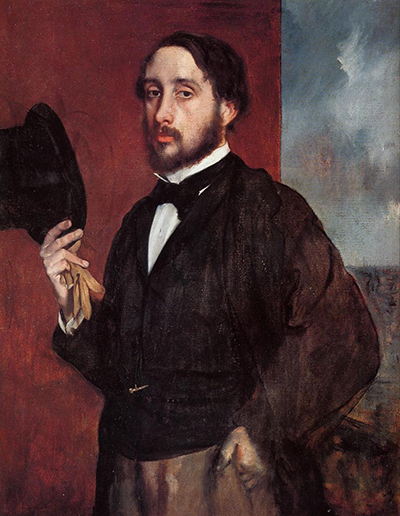During the 1850's and 1860's, Degas has painted a collection of 15 portraits, where two were self-portraits.
Some of these other portraits are Head Of A Young Woman, Portrait Of James Tissot, and Madame Gobillard Yves Morisot. Degas felt that it was time for him to shift his work from showcasing endless pastel pieces of nude woman, and instead depict portraits of those around him. His self-portrait is commonly used to illustrate how the artist looked. Degas is believed to appear to be roughly 30 years old within the portrait. Degas proudly places himself as the focal point of the work, by placing his body near the centre of the frame. The stunning piece is a moment of self-adoration by the artist, as he showcases himself for the world to see in criticism of himself.
Degas stands in an upright position near the centre of the canvas, yet with his body turned. The artist is well known for creating interesting perspectives in order to capture more depth to the piece. Degas stands sideways shifting his body slightly to the centre for the viewer to see. He is dressed in a black vest, with a white-collar undershirt beneath. Near his neck, a classic bow tie lines the collar. On top of the black vest, Degas wears an oversized darkened coat that falls towards the floor. Rather than being dressed in a black suit, Degas wears beige brown pants beneath. Degas uses additional colours and brush strokes to add colour and dimension to the pants. His left arm is bent to his side as he placed his hand into his pocket partly.
The artist's other hand is also bent gently as he holds a black top hat for the viewer to see. It's brilliant to witness the immense detailing Degas used to illustrate his fingers. Upon looking closely at his hand, the viewer is able to witness a light yellow-orange glove. It is argued by art historians that this glove is meant to pay tribute to Titan. This black hat and yellow glove add greater characteristic and elements to the painting. Rather than solemnly standing for the viewer to analyze him, he guides their direction onto his hand holding onto the items. It is as if Degas wants the viewer to analyze these contents and wonder what message he is attempting to send through the canvas. Perhaps, Degas is taking off his hat to the viewer in respect for looking at his work.
Nevertheless, it is an endless question to debate as there are no answers. The artist's face remains emotionless looking into the viewer. His large round eyes hold elements of generosity, while also great depth to them. They seem to hold endless emotions, without being able to pin a certain one down. Degas frames his face with a dark beard that covers his mouth. Small orange lips jump towards the screen onto the viewer. His pale skin is slightly illuminated by light peering into the centre of the canvas. The artist's hair falls onto the side of his face in a clean manner. It's amazing to witness the artist finally showcase himself in his work, rather than constant differing individuals. The viewer feels as if they're able to truly get to know the artist for who he truly is, rather than constantly looking at other people he encountered throughout his life.
The background of the painting seems to be broken into two parts. A deep burgundy wall covers the left side in rich hues or burgundy. Towards the right side, it seems as if a balcony lines the bottom breaking off into a deep blue sea. This is a classic renaissance style that showcases never ending depth through the ocean that goes on for what seems to resemble forever.




